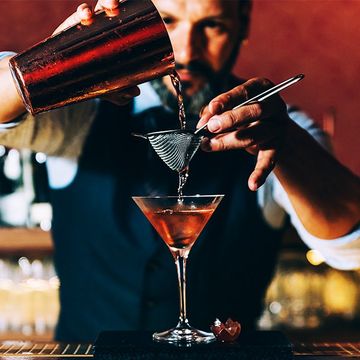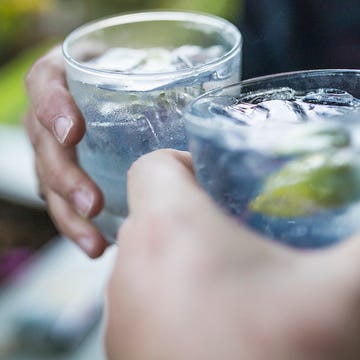Drinking wine is easy. Describing wine? Not so much.
You might not know the difference between medium- and full-bodied wines, or what the hell tannins are. But such knowledge can come in handy when you want to pick a nice bottle for date night, or sound smarter than your friends at the next dinner party. Whatever your goal, here’s your very basic guide to understanding wine.
What Wine “Body” Means
When people talk about a wine’s body using words like “light,” “medium,” and “full,” they’re referring to how thick the wine actually feels on your tongue, says Keith Wallace, president and founder of the Wine School of Philadelphia.
Think about the difference between swishing skim milk, whole milk, and heavy cream in your mouth. “That’s the perfect way to differentiate light-, medium-, or full-bodied red wines,” says Wallace.
White wines don’t adhere to that milk analogy. But people still describe them using the same terms. When you understand that body is a feeling, not a flavor, you’ll find it easier to identify a wine’s body type the next time you take a sip.
Helpful hack: Restaurant wine lists are often ordered from lightest to fullest body type, Wallace says.
Body also usually corresponds to alcohol content. Wines that are at least 13 percent alcohol-by-volume (ABV) are heavier in body than wines with lower ABV.
Related: The Better Man Project—2,000+ Scientific Tips and Tricks For Living a Kick-Ass Life
The Six Most Popular Grapes
Winemakers around the world use dozens of different grape types to make vino. But there are six grapes—three white, three red—that you’ll encounter more than any others, according to master sommelier Andrea Robinson, author of Great Wines Made Simple.
Each of these grapes also correlates with one of the three body types (light, medium, and full), she says.
In order from white to red and lightest to fullest body, the “Big Six” are:
1. Riesling; white grape, light body
2. Sauvignon Blanc; white grape, medium body
3. Chardonnay; white grape, full body
4. Pinot Noir; red grape, light body
5. Merlot; red grape, medium body
6. Cabernet Sauvignon; red grape, full body
Some of these grapes can be lighter- or fuller-bodied depending on the winemaker’s style. And of course there are lots of other grapes you’ll see all the time on wine lists and in shops—like Pinot Grigio (white grape, light body) and Malbec (red grape, medium to heavy body).
But get to know the Big Six, and you’ll have a solid frame of reference when tasting every other wine in the world, Robinson says.
Helpful hack: When you’re shopping for these wines, look at the shape of their bottles. Chardonnay and Pinot Noir tend to come in a rounder bottle than the narrow vessel popular among the other Big Six grapes.
Why look at the bottles instead of the label? In Europe—where grape names often aren’t listed—you’ll find winemakers often play by the same bottling rules. So seeing a red wine in a Pinot-shaped bottle will tell you it’s likely lighter-bodied.
How to Identify Wines From Around the World
Outside of Europe, most wines are identified by the type of grape used to make them, says sommelier Madeline Puckette, founder of the wine education site WineFolly.com.
But European wines are classified by region, not grape type, she says. For example, Bordeaux and Rioja are regions in France and Spain, respectively.
Related: The 20 Best Wines For Under $20
Helpful hack: Europe has many, many wine regions that take time to master. It’s easier to figure out which grapes you like in the U.S., says Puckette.
If you want to try a European wine, ask your waiter for something from Italy or France that’s similar to the grape you know and like.
What Is Tannin?
All wine contains “tannin,” a substance that comes from the skin of the grapes made to produce the wine, Puckette explains. Like a wine’s body, you can actually feel tannin when you take a sip.
“Tannin is that sensation of your mouth being dried out,” she says.
The more tannin in the wine, the more you’ll feel like all the saliva in your mouth has evaporated after you’ve swallowed your sip.
Helpful hack: White wine usually contains far less tannin than red wine, Puckette says. Tannin is more noticeable in fuller-bodied, higher-alcohol wines.
Why You Should Swirl Your Wine
Ever see people spin and swirl wine around in their glass before taking a sip? It may look ridiculous, but if you don’t swirl, you might as well buy the cheapest wine on the list, says Wallace.
“Swirling helps release the wine’s aroma, and that’s where a lot of the flavor comes from,” he says.
Helpful hack: To swirl the wine, grab your glass by the base of the stem with your index finger and thumb. Now pretend you’re drawing small circles with it on the tabletop, Puckette says.
Related: Why Wine From a Box Tastes Better Than You Think
You may have heard to examine the wine’s “legs”—the streaks of liquid left on the inside of the glass—after you swirl. The more legs, the better quality the wine.
But the truth is, there is no truth behind that, according to experts. The legs don’t equate to a better-tasting wine.
How to Tell If Wine Is “Corked”
When your waiter brings your bottle to the table, he’ll likely hand you the cork and pour a small amount of wine into your glass.
Here’s why: “The cork thing comes from the olden days—like, pre-Prohibition—when the bottle you ordered might have been refilled with some other cheaper wine,” Puckette explains.
Bottles didn’t come labeled back then. So seeing the wine maker’s stamp on the cork would assure the buyer it hadn’t been emptied and rebottled, she says.
As for that small amount of wine in your glass, it isn’t so you can decide whether you like the wine’s taste, but rather, so you can give it a good sniff to verify the wine isn’t “corked”—an expression for wine that’s gone bad, says Puckette.
Helpful hack: While rare, 1 to 2 percent of bottles are corked. “Take that glass, swirl it, then sniff it and imagine a wet dog—or a city alleyway with musty cardboard,” says Puckette.
If you smell those damp, musty aromas, it’s corked. Send it back.
Why You Should Let Your Wine Breathe
When you pop a bottle’s cork, oxygen flows into the bottle and changes how the wine tastes.
This is called “decanting” the wine, or letting it breathe, says Steve Wildy, wine director for Philadelphia’s Vetri Family restaurants.
Many people think giving full-bodied red wines some time to breathe—anywhere from a few minutes to a few hours—improves their flavor, Wildy says. (White wines aren’t decanted.)
Helpful hack: If you open the bottle and the wine tastes a little too sharp or edgy, let it sit for a couple minutes, says Wildy. You may find it tastes better. Some fine wines may take longer—even a few hours—to fully “open up” and taste their best. So if you’re treating guests to something kickass, you may need to open it long before they arrive.
At most restaurants, if the wine really needs to breathe—like a nice bottle at a steak house—the staff will decant it, which speeds up the process. If it’s an inexpensive bottle, it’ll breathe in your glass and be fine after 5 minutes.
Related: The Best Way to Save Leftover Wine
What a Wine’s “Vintage” Means
A wine’s “vintage” is the year in which it was bottled. Many wine novices assume if they’re holding two bottles of the same wine from different vintages, the older wine will be better.
Not true: Many more people are drinking wine these days than even 20 years ago, so winemakers are mass producing wines with methods that ensure they’re delicious right when they’re released, Wallace says.
In fact, if you inspect the shelves in wine stores, you may see two vintages of the exact same wine, and the younger is more expensive.
Helpful hack: Some pricey wines are still made to be aged, but most bottles will taste best if you pop the cork today or in the next few months, Wallace says.













